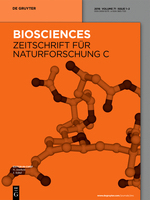A New Lignan from Brazilian Propolis
V. Bankova, N. Nikolova, M. Marcucci
Published Online: 2014-06-02 | DOI: https://doi.org/10.1515/znc-1996-9-1019
The known flavonoid kaempferid 4 and a new benzofurane lignan 1 were isolated from Brazilian propolis. The new lignan is a suitable taxonomic marker and gives new possibilities for identification of propolis plant sources in the tropical regions
Citation Information: Zeitschrift für Naturforschung C, Volume 51, Issue 9-10, Pages 735–737, ISSN (Online) 1865-7125, ISSN (Print) 0939-5075, DOI: https://doi.org/10.1515/znc-1996-9-1019.
Introduction
Propolis (bee glue) is a resinous material col lected by honey-bees from different plant exu dates and used as a general purpose sealer in the construction of the hive. It is known to possess a broad spectrum of biological activities: antibacte rial, antiviral, fungicidal, anti-inflammatory, anti tumor, immunomodulatory, local anaesthetic etc. (Marcucci, 1995). The bud exudates of different poplar species are the main sources of bee glue in the temperate zone incl. Europe, Asia and North America (Greenaway et al., 1987, Bankova et al., 1992, Wollenweber et al., 1987). For this reason the chemical composition of propolis samples originating from these regions is charac terized by the same main components: flavonoids and esters of substituted cinnamic acids (Mar cucci, 1995). The origin and chemistry of tropical propolis is still an open question, and only few communications have been published on the chemical composition and possible plant sources of bee glue from Brazil and Venezuela (Aga et al., 1993, Tomas-Barberan et al., 1993, Bankova et al., 1995). In this work, we report the isolation of a new lignan from Brazilian propolis. Till now, different phenolic compounds have been found in propolis but this is the first isolation of a lignan from it.
* THESE STATEMENTS HAVE NOT BEEN EVALUATED BY THE FOOD AND DRUG ADMINISTRATION. THIS IS NOT INTENDED TO DIAGNOSE, TREAT CURE OR PREVENT ANY DISEASE.
